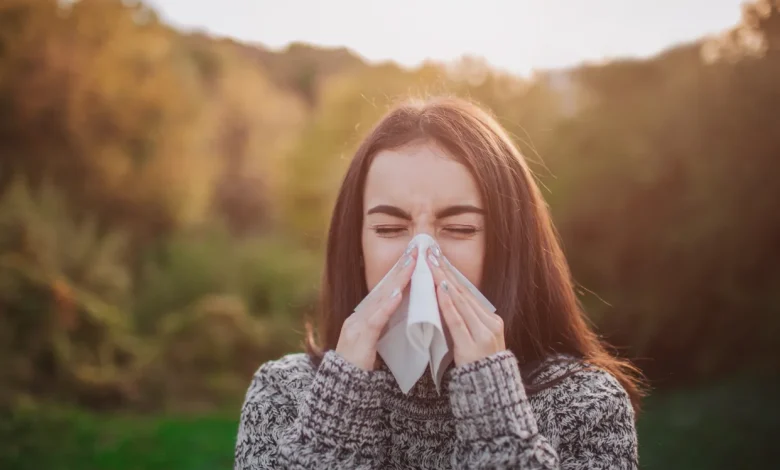Are your dark under-eye circles caused by allergies? What’s the right way to use nasal spray? A health editor’s guide to seasonal allergies.

It’s allergy sneezon season, which means that you’re not alone if you’re experiencing watery, itchy eyes, a stuffy nose, and a shortage of tissues, as many of my close friends are. According to an April Yahoo News/YouGov survey of 1,746 American adults, 46% of people suffer seasonal allergies, and 22% have missed work or school as a result of their symptoms. If you’re one of them, continue reading for advice on how to help manage them better.
🤧 What I learned … you can blame ragweed — and climate change — for your sniffling and sneezing
Every season brings with it a unique set of allergies. And ragweed is that for autumn, which can cause allergic rhinitis, also known as hay fever. The 23 million Americans who suffer from ragweed allergies suffer greatly from the up to 1 billion pollen grains that each ragweed plant, despite its short lifespan of just one season, may produce.
Furthermore, if it seems like the seasonal allergy season is lasting longer than normal, it is; you are not delusional. It’s obviously obvious why—climate change is to blame. As per the Environmental Protection Agency (EPA), the growing season of ragweed and other plants is extended by warmer autumn temperatures. In addition to raising temperatures, higher carbon dioxide concentrations also lead to increased pollen production in ragweed and other plants. Furthermore, the EPA claims that the pollen produced by these plants is likewise more allergic.
👂 What I heard … dark under-eye circles could be caused by allergies
Dr. Zachary Rubin, an allergist and immunologist, recently posted a TikTok about “allergic shiners.” The Cleveland Clinic claims that hay fever-induced nasal congestion is the root cause of them. The area under your eyes may appear swollen and dark, resembling a bruise, due to congestion that slows blood flow around the nose. Allergies are one of the many causes of dark under-eye circles, especially if you also experience other symptoms like runny nose or itchy, watery eyes. Other causes include not getting enough sleep, genetics, ageing, and more. What then can be helpful? To lessen nasal congestion, try taking your allergy medicine as prescribed. You can also try applying cold compresses to the affected area and elevating your pillow at night to improve fluid drainage.
🍁 What I’m doing … getting out in nature
One of my favourite methods to exercise and decompress at the same time is to take a stroll in my neighbourhood park, especially in the autumn when the leaves are changing. In actuality, only twenty minutes in nature can strengthen your immune system and reduce stress. However, going outside could seem like the last thing you want to do if you have seasonal allergies. However, you don’t have to (though it’s not the worst idea) spend all of your time indoors with your windows closed to avoid allergies. The secret is to schedule your walks wisely. For instance, the morning is when ragweed pollen counts are at their peak, so you might want to postpone your walk until later in the day. Check the pollen count before going outside as well. You can find out the pollen count in your neighbourhood with this helpful tool from the Allergy & Asthma Network (AAN).
👃 What I read … there’s a right way to use nasal spray
Although nasal sprays are generally quite easy to use, there are a few tips to ensure that you’re taking the medication as prescribed. Although it may seem preferable to aim for the middle of your nose, the AAN advises pointing the nozzle in the direction of your ear to ensure that the mist reaches the rear of your nose and avoids damaging your septum, the tissue that divides your nostrils. AAN advises using your left hand to apply the medication to your right nostril and switching to your left hand for the opposite side. Finally, after applying the nasal spray, wait at least 15 minutes before blowing your nose, despite how tempting it may be if the medication spills.
🍴 What I’m planning to make … soy-glazed ginger turkey meatballs
Good meatballs are loved by all. Even better when it only requires around 30 minutes to prepare and is loaded with healthy components. Fresh ginger and garlic are used in this recipe for soy-glazed ginger turkey meatballs, which not only adds a taste explosion but also strengthens the immune system and has inherent anti-inflammatory qualities. That is useful for allergy sufferers as well as for the impending cold and flu season. Quercetin, which is mostly found in garlic, has the ability to reduce the release of histamines. Another is vitamin C, which can lessen runny nose and sneezing, two signs of allergic rhinitis. The greatest foods to eat for vitamin C include broccoli, strawberries, kiwis, and red peppers. It’s crucial to remember that these foods are nutritious supplements to your normal diet that may help you sniffle a little less than prescription allergy drugs.




